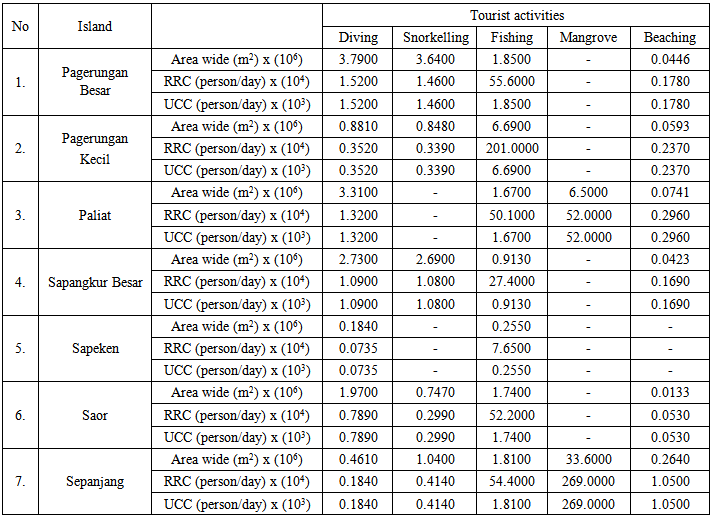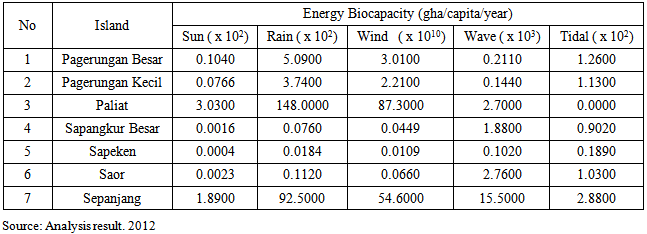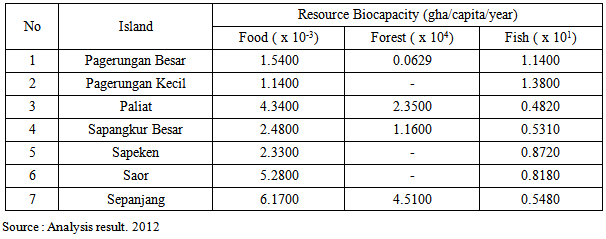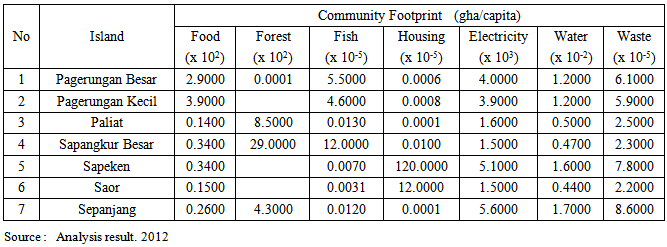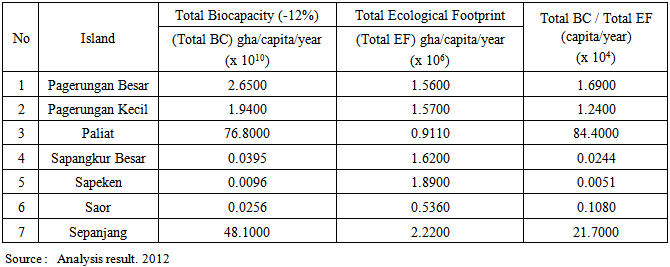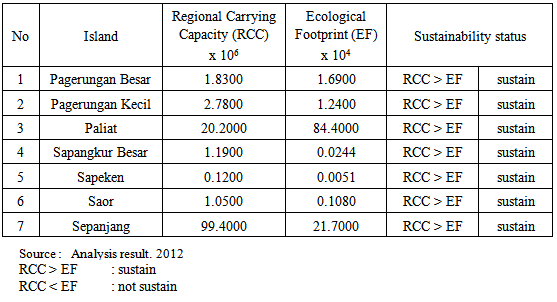-
Paper Information
- Next Paper
- Paper Submission
-
Journal Information
- About This Journal
- Editorial Board
- Current Issue
- Archive
- Author Guidelines
- Contact Us
International Journal of Ecosystem
p-ISSN: 2165-8889 e-ISSN: 2165-8919
2014; 4(4): 190-196
doi:10.5923/j.ije.20140404.05
Sustainable Tourism Based on Carrying Capacity and Ecological Footprint at Sapeken Archipelago, Indonesia
Agus Romadhon1, Fredinan Yulianda2, Dietriech Bengen2, Luky Adrianto2
1Department of Marine and Science, Trunojoyo University, Kampus Unijoyo, Telang, PO. BOX 2 Kamal Bangkalan
2Faculty of Marine Science and Fisheries, Bogor Agricultural University
Correspondence to: Agus Romadhon, Department of Marine and Science, Trunojoyo University, Kampus Unijoyo, Telang, PO. BOX 2 Kamal Bangkalan.
| Email: |  |
Copyright © 2014 Scientific & Academic Publishing. All Rights Reserved.
As sustainability has become an important policy issue in small island tourism, there is need to understand the natural limits. These used to know how much small island with their limitation could accommodate tourism needs. Based on that fact, this research aimed to: 1) quantify the environmental carrying capacity for several type of ecotourism in Sapeken archipelago; 2) assessing Sapeken archipelago ability to accommodate ecotourism activities using ecological footprint based from emergy approach; and 3) evaluate sustainability ecotourism activities in Sapeken archipelago. Result showed: 1) Sapeken archipelago have different carrying capacity for each type of ecotourism. For dive tourism 5,330 persons/day, snorkelling 3,590 persons/day, fishing tourism 14,900 persons/day, mangrove tourism 32,100 persons/day and beach tourism 1,990 persons/day; 2) The largest accommodate for tourism are Paliat island (844,000 persons/year) Sepanjang island (217,000 persons/year) and smallest in Sapeken island (50.5 persons/year); and 3) Ecotourism activities in Sapeken archipelago has sustainability (RCC > EF) which indicated by carrying capacity as natural limit is greater than EF as a representation number of tourist can be met.
Keywords: Sapeken archipelago, Carrying capacity, Ecological footprint, Sustainability, Ecotourism
Cite this paper: Agus Romadhon, Fredinan Yulianda, Dietriech Bengen, Luky Adrianto, Sustainable Tourism Based on Carrying Capacity and Ecological Footprint at Sapeken Archipelago, Indonesia, International Journal of Ecosystem, Vol. 4 No. 4, 2014, pp. 190-196. doi: 10.5923/j.ije.20140404.05.
Article Outline
1. Introduction
- Sapeken Archipelago is an area consisting of a number of small islands with a several supporting ecosystems such as coral reefs, mangrove ecosystems, coastal ecosystems and fisheries resources [1], indicated as a region with high diversity and susceptible to utilization activities as well [2]. In this regard, the utilization of Sapeken archipelago is in accordance with their limitation as small islands. One of the utilization of small islands is ecotourism activities. Ecotourism is defined as trip activity to places that are relatively not interfere the places, with the purpose of observing and enjoying biological resources, by minimizing environmental impact so as to encourage respect for the local culture and produce benefits that are fair to all users [3]. Moreover, The International Union for Conservation of Nature (IUCN) said that an ecotourism activity is not only nature-based, but also as an effort to maintain biodiversity while improving the welfare of the local community. However, without adequate planning, the purpose of the ecological balance, social, and economic in ecotourism will not materialize and instead the implementation will be causing damage to the environment [4]; [5]; [6].Based on reason above, the planning of ecotourism activities at Sapeken Archipelago requires an assessment of the ability of their ecosystems to provide all aspects required to implement sustainable tourism activities. The assessment approaches used are in the form of: 1) an assessment of the regional carrying capacity (RCC), 2) an assessment of touristic ecological footprint (TEF), and 3) an assessment of the sustainability of ecotourism activities.
2. Methodology
- This research was conducted at Sapeken Archipelago that formed from a series of small islands chain totalling 201.887 Km2 areas. The islands chain are located at 6° 46 '- 70° 6' LS 115° and 115° 10'-44 'E, part of the District of Sapeken, Sumenep regency, East Java Province (Figure 1). Primary and secondary data were collected from the study sites as well as from various agencies in Sumenep Government and other relevant agencies.
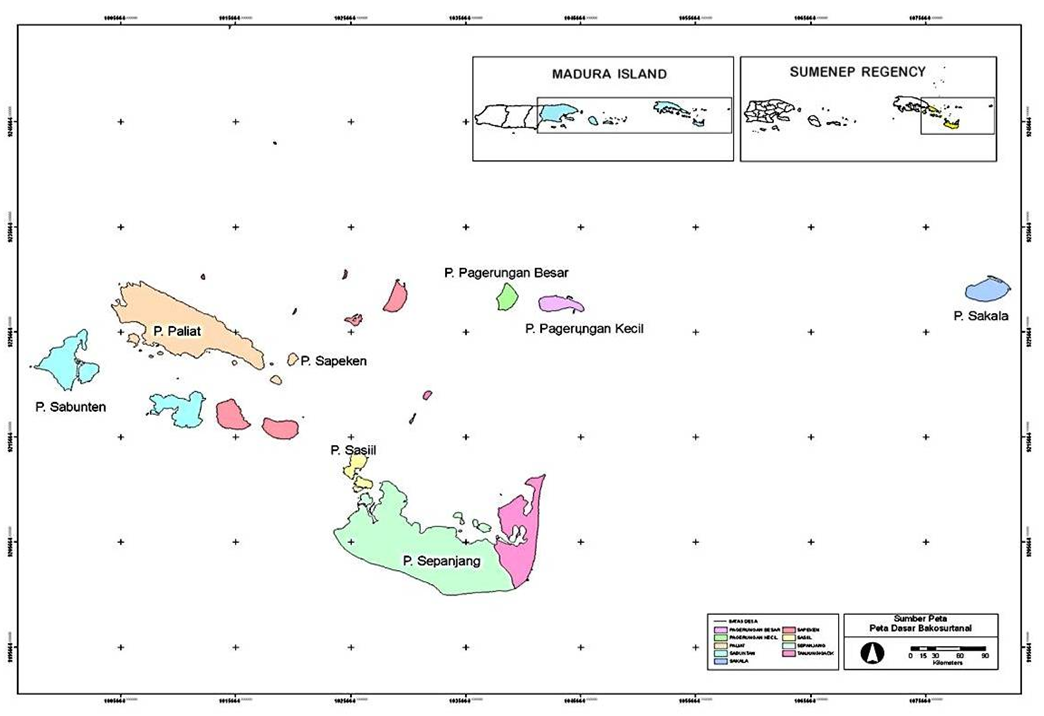 | Figure 1. Map of study area at Sapeken Archipelago |
2.1. Utilization Carrying Capacity (UCC)
- UCC was used to determine the maximum number of visitors that physically can be accommodated in the specific space and time without causing interference with the natural and human. UCC and RCC were calculated with following equation [11]:
 | (1) |
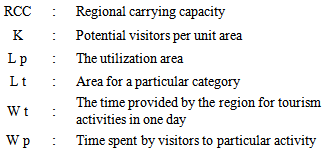
 | (2) |
2.2. The Ability of Sapeken Archipelago Ecotourism Activities
- The ability of Sapeken Archipelago ecotourism activities was assessed using ecological footprint (EF) based on the concept of emergy synthesis consists of three stages, i.e : 1) calculate or assess their biocapacity, covering energy capacity and resources capacity, 2) calculate or assess community ecological footprint, and 3) calculate or assess touristic ecological footprint.− Biocapacity of Sapeken ArchipelagoEmergy is one form of energy that has undergone a transformation in the form of energy flow [12]; [13]. Energy biocapacity was calculated following. [14]. include solar energy, wind, rain energy, wave energy, and tidal waves. Meanwhile, the resources capacity includes food energy, energy forest and fishery energy [15]. The unit used of energy is solar em joules (seJ). The conversion of energy and / or mass to emergy, calculated using emergy intensity factors (eif)
 | (3) |
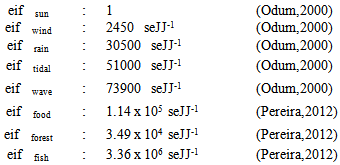
 | (4) |
 − Community Ecological footprint of Sapeken ArchipelagoThe calculation refers to the ecological footprint assessment and analysis conducted by Scotti et. al [16]. Equations used are as follows:
− Community Ecological footprint of Sapeken ArchipelagoThe calculation refers to the ecological footprint assessment and analysis conducted by Scotti et. al [16]. Equations used are as follows: | (5) |
 − Touristic Ecological Footprint EF of ecotourism plan products is the total accumulated value of the seven components of the previously mentioned [17]. The total value was shown by the following equation:
− Touristic Ecological Footprint EF of ecotourism plan products is the total accumulated value of the seven components of the previously mentioned [17]. The total value was shown by the following equation: | (6) |
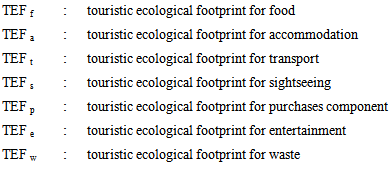
2.3. Sustainability of Ecotourism Activity
- Sustainability assessment for the utilization of Sapeken Archipelago for ecotourism activities performed by comparing the RRC with the EF with following equations:
 | (7) |
3. Results and Discussion
3.1. UCC of Sapeken Archipelago for Ecotourism Activities
- UCC is the maximum number of visitors that limited by the condition of the ecosystem as a natural limit. Ecosystem natural limit for ecotourism based on the results of conformity assessment activities for various types of ecotourism. Table 1 showed the results of UCC assessment of Sapeken Archipelago for ecotourism activities.
|
3.2. Regional Capacity of Sapeken Archipelago for Ecotourism
- Regional capacity of Sapeken archipelago is the quantity of regenerative capacity of the biosphere that is used by tourist activity, carried out by counting the amount of biologically productive land and catchment area required to support a given population at current levels through the consumption and resource efficiency. These assessments includes: 1) biocapacity, consisting of energy and resource biocapacity as supply and 2) ecological footprint, consists of community and touristic ecological footprint as demand. The results of an assessment of the regional capacity of Sapeken Archipelago for ecotourism were showed in Table 2;3; 4; 5 and 6.
|
|
|
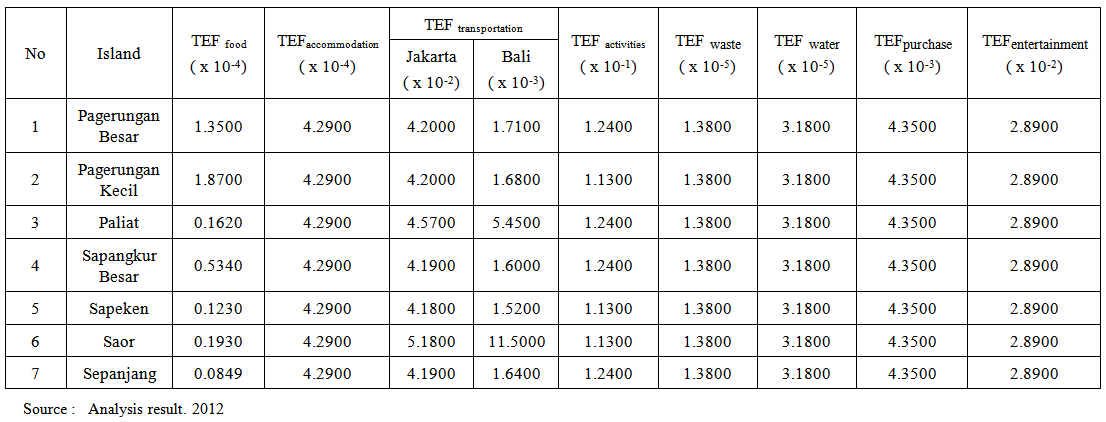 | Table 5. Touristic ecological footprint of Sapeken Archipelago (gha/capita) |
|
3.3. Sustainability of Ecotourism Activities in Sapeken Archipelago
- Based on the understanding of ecotourism as social-economic-environmental complex system. an assessment of the sustainability of ecotourism activities in the Sapeken Archipelago were based on the value of RCC that represented the ecological/environmental carrying capacity as the loading capacity and the aggregate value of the ecological footprint (EF) that characterized the socio-economic carrying capacity as a supporting capacity. RCC value and EF aggregate value were compared to obtain the sustainability status of ecotourism activities in the Sapeken Archipelago. Furthermore. [24] described the carrying capacity and the ecological footprint was measured in the same units that can be compared directly. If the value of the ecological footprint (EF) is less than the carrying capacity value. ecotourism activities will be sustainable and vice versa. The results of the comparative value of the RCC and EF at Sapeken Archipelago were showed in Table 7.
|
4. Conclusions
- Sapeken Archipelago has utilization carrying capacities (UCC) which vary for different types of ecotourism activities. The largest UCC on each type of tourist activities was mangrove tours (32,100 persons/day), following by fishing (14,900 persons/day); diving (5,330 persons/day). snorkelling (3,590 persons/day); and beaching (1,990 persons/day).Total comparative value of total biocapacity with the total ecological footprint represents the ability of each small island in the Sapeken Archipelago to accommodate and meet the needs of visitors in tourism activities. The largest number of tourists that can be accommodated were found in Paliat Island (844,000 persons/year) following by Sepanjang Island (217,000 persons/year), while the smallest value were found in the Sapeken Island (50.5 persons/year).Related to the planning of ecotourism activities (ecotourism) in Sapeken archipelago by looking at the of availability status of ecosystem services (budgets), it is possible to be developed. Conditions of some natural capital assets that is still able to provide a number of ecosystem services that can be used as a tourism attraction.Lastly, assessment of carrying capacity for ecotourism based on ecological footprint should be integrated in the planning of tourism activities. in order to provide existing condition in-depth overview related to small island ability for tourism as sustainable development.
ACKNOWLEDGEMENTS
- We gratefully acknowledge the anonymous reviewers.
 Abstract
Abstract Reference
Reference Full-Text PDF
Full-Text PDF Full-text HTML
Full-text HTML